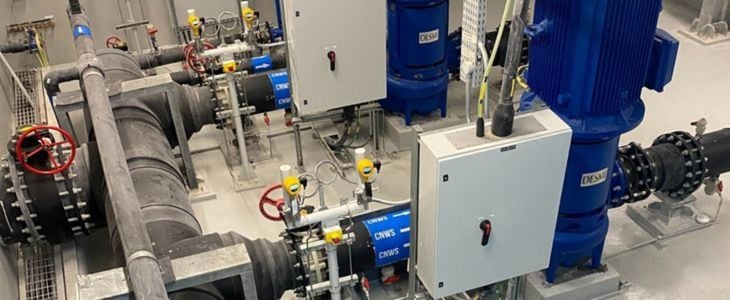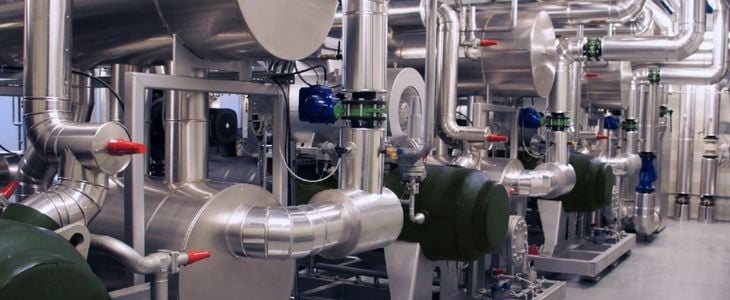While ground source heat pumps have been around since the late 1940s, they’re living a particularly favorable moment at the time. As more private and public entities seek ways to advance towards sustainable heating technologies, the use of ground source heating stands out as particularly environmentally friendly.
Using the relatively constant temperature of the earth in its advantage, this piece of technology is able to reach high efficiencies, providing not only sustainable but also cost-efficient performance in the mid and long term.
Learn more about ground source heat pumps and how to access the right one for your project.
What are ground source heat pumps
Ground source heat pumps (also known as geothermal heat pumps) are a heating/cooling system able to transfer heat to to the ground or to diffuse it here.
As we’ve mentioned above, these systems take advantage of the relatively constant temperatures of the earth through the seasons, compared to air temperatures. While thermal values on the surface layer are sensitive to weather, temperatures at the deeper layers tend to be constant.
As such, ground source heat pumps remain an extremely energy-efficient technology for heating, cooling and water heating, especially when compared with other systems such as boilers or electric heaters.
What is the working principle of ground source heat pumps
Ground source heat pumps use electricity to extract heat from a steady source and provide it for end users; while, during the summer, heat pumps are able to remove heat from a space and disseminate it underground.
As for their components, a key element is the ground heat exchanger: this component is in contact with the groundwater and able to extract or eliminate heat.
Additionally, another key element is the pipework required to conduct water and antifreeze liquids, which are themselves in charge of transferring heat from the source to the desired end consumers.
Types of ground source heat pumps
Horizontal ground source heat pumps
This type of ground source heat pump consists of a horizontal closed loop circuit installed in a plane in the ground. Tends to be the adequate structure for residential installations.
Vertical ground source heat pumps
This system requires the generation of a borehole between 50 to 400 feet deep, where U-shaped pipes are installed. Used for heating when horizontal ground source heat pumps are not an option, the structure can be integrated with the foundation piles.

Radial or directional drilling pumps
This system allows for the incorporation of a mini horizontal directional drilling (mini-HDD), having loops and piping laying under soil without providing a big disturbance to it. It’s typically the option for retrofitting projects (upgrading a property after it has been built).
Open-loop pumps
Also known as groundwater heat pumps, this system pumps natural water from a body of water (such as a pond) and transfers it into a heat exchanger, effectively using this liquid as a heat exchange fluid. After the liquid has been circulated through the system, it returns to the ground. This system requires additional measures to avoid corrosion issues.
Closed loop heat pumps
Closed-loop geothermal heat pumps circulate antifreeze liquids through a closed loop of pipes, which can be buried in the ground or submerged in water. In the case of direct exchange systems, the heat exchanger is not needed, while larger compressors must typically be installed.
Ambient loop systems
The ambient loop heat pumps transfer water at medium temperatures in distribution networks able to provide heat or remove it for final consumers as part of district heating initiatives.
What are the benefits of ground source heat pumps
- Efficiency: both in terms of cooling performance (measured by energy efficiency ratio or EER) and heating performance (measured using the coefficient of performance or COP), ground source heat pumps are able to provide a total energy output much greater than the electrical input.
In fact, COP values may reach between three to five times more energy than the electric energy the heat pump consumes, as well as reducing energy consumption up to 72% compared to electric resistance heating with standard air-conditioning equipment. This has led the US Department of Energy to qualify ground source heat pumps as extremely efficient. - Decarbonization: ground source heat pumps are hailed not only as one of the most energy-efficient ways of achieving heating, but also as part of producing energy that is environmentally clean. This is particularly true when the electricity is produced from renewable resources, able to produce zero emissions locally as part of 5th generation district heating systems.
- Costs: while the costs of installing a geothermal system are higher than other traditional air-source systems, ground source heat pumps stand out for their ROI capacities. Additionally, the US Department of Energy has calculated that homeowners with access to ground source heat pumps enjoy savings of around 70% when compared to traditional systems. This is especially true in a moment when fossil fuel dependency translates into price unpredictability and rising costs.
- Long lifespan and low maintenance: the typical lifespan of ground source heat pumps adds up to 25 years for the ground loop and 15 years for the heat pump. These are also systems with little maintenance needs compared to traditional systems.

How to access the right type of ground source heat pump
Achieving a balance between sustainability, energy efficiency and economical viability requires accessing the right kind of ground source heat pumps according to the needs of each project.
This is where the expertise of heating and cooling engineering comes in, guaranteeing adequate ground source heat pumps are chosen considering the needs of each project as well as its possibilities (such as access to locally-available energy sources) in order to optimize performance and sustainability.
At Araner, we are committed to help companies have access to the heating and cooling technologies they need. Through our two-decade heating and cooling engineering expertise, we’re able to provide an end-to-end service for ground source heat pumps, as well as being able to devise tailor-made district heating systems that ensure low operating costs and carbon neutrality.
Our work involves the concept design and analysis stage, the consideration of cost-benefit ratios as well as the selection and testing of different technology models, the generation of a complete project overview, the manufacturing and control process and the testing and supervising of all processes, including maintenance needs.
Additionally, we’re able to provide technical knowledge to explore the current possibilities in thermal energy efficiency, including state-of-the-art industrial heat pumps, Thermal Energy Storage tanks and Turbine Inlet Air Cooling systems.
Want to know more about our work and how to access high-quality ground source heat pumps that can take your project’s efficiency and sustainability to the next level? Download our free ebook about district heating and explore all current possibilities regarding sustainable heating and cooling; or get in touch with us to speak to our team about how to optimize heating technologies and maximize your project’s energy efficiencies by applying ground source heat pumps.










